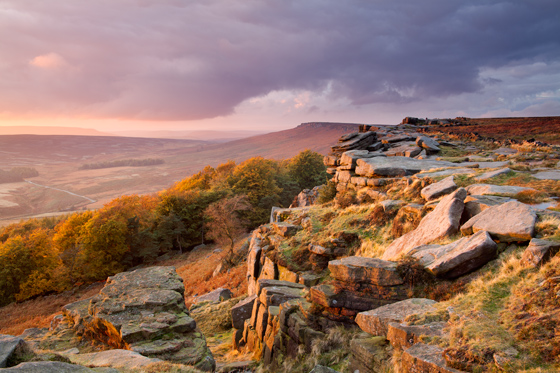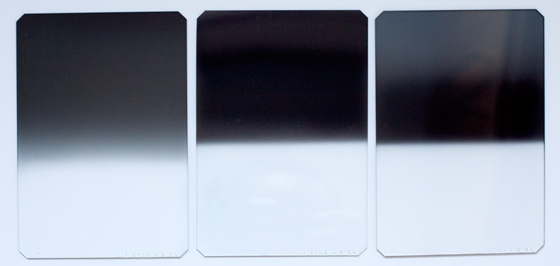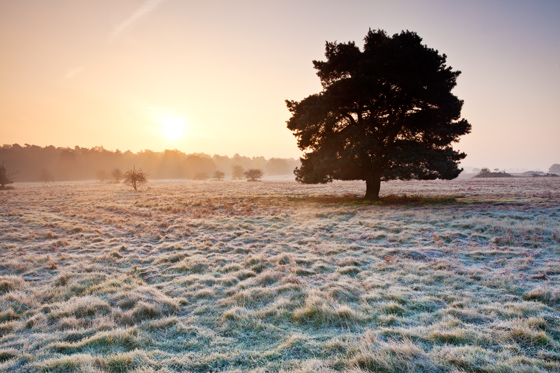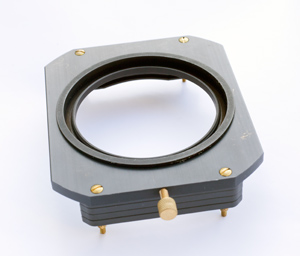Hietch ND Grad Filter Review
The reason landscape photographers use ND Grad filters is that cameras simply cannot record the same level of detail that the human can. When the sun is low in the sky or not yet risen then there is a much wider tonal range for the camera to capture. The filter is toned with a darker area at the top of the filter and a clear area on the bottom half. The darker area is a neutral colour and tones down the exposure over the sky proportion of the scene. This bridges the contrast range between the darker foreground and brighter sky and makes for a more evenly exposed image with good detail and colour in the sky and a lot more detail in the foreground. The above example shows a scene captured without a grad and then a second image captured with a grad filter.
Like many landscape photographers I started with the Cokin filter system. However, I found I was always experiencing the classic problem of the infamous Cokin colour cast. After struggling along with the Cokin system for some time I had heard a few good things about the Hitech system as a good alternative. I quickly invested in an 85mm set of Hitech ND Grads. Immediately I saw a massive difference. I continued using the filters for about a year, then as I upgraded to the wider Canon 17-40mm lens, a move from the 85mm size filters was required. I opted for the Lee filter system, and like most Lee users I have been a happy user ever since.
The move to Lee filters was about 8 years ago now; however I often recommend Hitech filters to my photography workshop participants as they represent a good trade-off between quality and price. The obvious problem with the Lee filters is their higher price. If you are serious about landscape photography and can warrant the cost then the Lee filters are well worth considering. However, for those occasional shooters, or the newcomers to photography who don’t want to fork out around £250 + on a filter system, then the Hitech system is well worth looking at.
A few years back Hitech filters generously provided me with a large number of new filter kits and holders for my workshop participants to try out on the courses. I thought it was finally time to try out a few of the filters myself to see how good they really were so here is my Hietch ND Grad Filter Review.
Although Hitech did send me a few of their ten stop filters I haven’t had a good chance to try these out yet so I will report back on this filter at a later date. The filters I am going to look at here are their ND Grads.
First let’s look at the Hitech hardware. Hitech have released a new modular filter holder, like the Lee holder you can add or take away slots and add or remove a 105mm front filter ring for polarising filters. On my own Lee holder I use a 105mm circular polarising filter on the front, this makes rotating the filter much easier. Due to the design of the Hitech holder it’s actually quite easy to just rotate the whole filter holder with a polariser attached to the lens behind, the brass screw on the side of the holder can then be loosened to quickly straighten up the holder. This is hard to explain here, but in practise is actually really quick and easy to do. This makes using a polarising filter behind the Hitech holder really easy to work with.
Adapter rings to attach the holder to the lens come in normal and wide angle versions; the wide angle ones are set back slightly and can help avoid any vignetting.
Hitech offer soft edge, hard edge and reverse densities for their graduated filters. The density relates to how quickly the grad changes from clear to dark. If you are just going for one set and you shoot lots of sunsets, costal scenes or general landscape stuff I would probably opt for the hard grads. When investing in filters I would always avoid the cheaper Chinese sets of filters you can get on ebay, they have a grad area that’s way too soft and these are useless not only for the optical quality of the filter, but because the grad area is difficult to place and the lower part of the sky will not have enough light blocked out.
 This stormy afternoon light in the Peak District was captured with a Hitech 0.6 Hard ND Grad
This stormy afternoon light in the Peak District was captured with a Hitech 0.6 Hard ND Grad
Soft grads can be more difficult and less effective when used on crop cameras, lenses with a smaller diameter and telephoto lenses. Where soft grads can be an advantage is if you shoot in areas where you have an uneven skyline, such as some mountain scenes, cityscapes and woodlands. With my own Lee filters I own both sets of Hard & Soft Grads, however the vast majority of the time it’s the hard grads that get used.
Hard grads are easier to place on the horizon level. One problem when shooting sunsets is the horizion level is normally the brightest area of the scene, but with the soft filter this can actually be the weakest part of the ND area and the sky can easily burn out in this part of the scene. This is less of a problem with ND hard grads as the horizon area of the filter is much darker and because of this it is more effective.
Where the reverse grad comes in to its own is when shooting sunsets or sunrises. A normal grad filter starts by being weakest on the horizon level and strongest at the top of the filter. With a lot of sunset or sunrise scenes the brightest area is obviously around the horizon level. The area of the sky where the filter doesn’t need to be quite so strong is actually the top. The Hitech reverse grad works by being darkest at the horizon level and slightly weaker as it rises to the top of the sky. This is a filter I have wanted for years and am really pleased Hitech have begun producing this one. It’s not going to be required all of the time; however it’s great to keep one or a set in the kit bag for those occasions when it is really useful. I have been trying this filter out for a few weeks now and am already beginning to wonder how I have managed without it for so long.
 Left Soft Grad, Middle Hard Grad & Right Reverse Grad
Left Soft Grad, Middle Hard Grad & Right Reverse Grad
Conclusion
I have been really impressed with the quality of the filters and the colours achieved. I have received no unwanted colour casts, in fact the colours achieved have been very realistic and true. The optical quality of the filter seems excellent with no loss of quality and lens flare has not been a problem at all. I must confess I haven’t shot in a situation where I have needed to stack any filters and this is where any colour casts could suddenly appear. If you do shoot raw then slight colour casts in the sky are probably less of problem now as they once were. Software like Adobe Lghtroom has a grad tool where you can apply adjustments to just the foreground or the sky, including adjusting the white balance / colour on one particular area which is great for correcting any slight colour casts.
 A frosty morning in Thetford Forest captured with a Hitech 0.9 Hard ND Grad
A frosty morning in Thetford Forest captured with a Hitech 0.9 Hard ND Grad
If I had to say one negative thing about the filters it would be that I find they can scratch a bit easier than the Lee filters. Most of this seems to have occurred when I have been taking the filters out and putting them back in the plastic wallets, these wallets do feel quite sharp and are quite a tight fit, especially when you have freezing hands. Personally I would house them in a soft filter wallet and not use the plastic pouches they come in. Both Hitech and Lee make such filter wallets and these are ideal to get at your filters nice and quickly whilst also protecting them much better. The black multi filter wallets also double up as an excellent tool to hold at the side of the lens to stop lens flare.
It would be a nice touch to see the more expensive larger size grad filters come in the soft cloth with the three pockets in, similar to how the Lee filters arrive. These can double up as good lens and filter cleaners as they always seem to be to hand and are ideal for this purpose. When shooting in wet weather keeping rain droplets off filters can be problematic. I like the soft pouches the Lee grads come in as you can just put the filter back in the soft pouch and it’s easy to wipe away rain droplets before taking it back out and being ready to shoot again.
All in all I have to say I have been pleasantly surprised with the Hitech filters, they seem so much better than the first set I was using over eight years ago now. I actually prefer the Hitech holder to the Lee holder. Would I change from the Lee filters though? The simple answer is no. With the Lee filters I have never had any problem in eight years of using them. At the larger size 100mm x 150mm (same as Lee), a set of hard grads, a filter holder and a wide angle adaptor is actually not that much cheaper for the Hitech kit compared to the Lee kit. I believe though that Hitech can offer kits consisting of a number of different filters which can result in quite a good saving. Hitech also offer their very own 105mm circular polariser at a good price, although I have no experience of this filter and do not know of any photographers who have used it so I can’t comment on how good it is. It’s also difficult to find any reviews online.
 Hitech 0.6 Hard ND Grad used at Winterton on the Norfolk Coast.
Hitech 0.6 Hard ND Grad used at Winterton on the Norfolk Coast.
If I didn’t require the 100mm x 150mm size grads then I would certainly recommend the smaller size Hitech filters as these do represent excellent value for money with a really high quality product. Compared to the Cokin filters it’s a no brainer in my opinion I would go for the Hitech every time.




